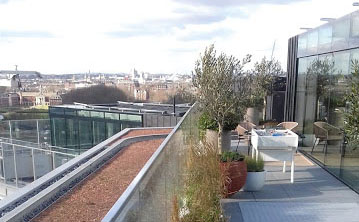
In recent years, green roofs have become increasingly popular throughout the UK, with industry experts estimating that the number of ‘gardens in the sky’ being installed across the UK has risen by 40% since the start of the decade. The earthy addition to conventional roof coverings has numerous ecological benefits, but there are also a variety of challenges that green roof systems offer installers, writes Lee Virgin, branch manager at BriggsAmasco.
PLAN AHEAD FOR GOOD PLANT-OUT
BriggsAmasco installs two types of green roof system – sedum and plug plant. Each has its challenges in terms of installation. The sedum mat is, generally, a more robust system to fit. It’s grown in a greenhouse before being rolled-up and transported to site. Good forward planning is essential to ensuring a smooth transfer from pallet to roof. A sedum mat will not survive on a pallet for longer than three days; therefore the roof’s waterproof base should be in positon in good time before its green layer arrives.
Plug plants arrive pre-potted and rooted – which is the same as buying from a nursery – and are planted onto a roof via a mixed substrate of mud and brick. An ecology report will determine how many plants are required per square metre, whilst the green layer is generally laid to a width of between 70mm and 100mm. The only potential issue with the installation of the substrate is people walking over it whilst it’s in situ. Plants need to be planted between April and September. Good logistics will again pay dividends to avoid projects finishing outside of these optimum times.
The main challenge of any roof installation is transferring the material – particularly the substrate – to the top of a building. For instance, laying a substrate to a thickness of 100mm across a 1,000-metre roof, that’s a few tonnes-worth of bags that need taking to the roof. In such instances, the process is made easier – though not necessarily quicker – by spreading the load and using more bags. This increases the amount of lifts, but ensures a safer operation. A hoist is often used to convey materials, a job that a crane could carry out far more time-effectively. Unfortunately, this equipment is generally only scheduled to assist in the lifting of large ME materials to the roof. Therefore, when installers arrive to plant the green roof, the crane has already been dismantled.
Following a project’s handover to the client, the green roof’s maintenance is provided by a qualified sub-contractor. A sedum roof doesn’t require a lot of maintenance. Generally, once established it thrives in the temperate – and occasionally damp – UK climate. Plug plants need to be nurtured and watered regularly – if not, the system will die. BriggsAmasco installs mansafe fall protection to ensure safety is maintained during a green roof’s upkeep.

THE CITY ROOF THAT NEVER SLEEPS
There can be no doubting the benefits a green roof brings to the environment. Aesthetically-pleasing and environmentally-friendly, it encourages a sense of health and well-being in a building’s occupants as well as adding a biodiverse layer to an otherwise grey, lifeless space.
The breath-taking redevelopment of the Battersea Power Station site in London provides a fine example of how a green roof system is being employed in a thoroughly-modern, residential and commercial complex. On behalf of main contractors, Carillion, BriggsAmasco was selected to install a multiple roof system for phase one of an eight-phase project which will eventually transform the derelict 39-acre site into a thriving mini-city, complete with retail stores, restaurants and bars, a six-acre park, a community theatre, and residential apartments. BriggsAmasco is in the process of supplying six green roofs and two lower – level roofs consisting of limestone paving. Each plug plant system is installed on top of a Hydrotech Monolithic membrane which provides excellent root protection and allows immediate access to waterproofed areas.
GREEN ROOF AT THE ‘FORE’ OF GOLF CENTRE INSTALLATION
BriggsAmasco has also delivered a green, watertight, waterproofing roof system for a sustainable, state-of-the-art golf equipment testing centre in Scotland.
The building, near St Andrews, has been designed with maximum energy-efficiency in mind, with an extensive sedum roof – its sustainable crowning glory. BriggsAmasco installed 1,600m2 of green roof on pitches of up to 25°- an incredibly challenging slope on which to carry out a very detailed application.
The Bauder waterproofing roof system comprises a sedum mat, a pre-cultivated vegetation blanket featuring up to 11 species of sedum together with mosses and grasses. Installed on metal decking, the mat will ensure plants grow to create a natural habitat for birds and insects to live and feed, thus maximising its biodiverse properties.
To allow for more natural daylight into the building, BriggsAmasco installed barrel vault rooflights. Applied on a continuous run across the roof, these will help increase the building’s energy-efficiency and cost-effectiveness.
The natural rays will also enhance the well-being of the occupants as well as reduce the building’s overall carbon footprint.
Despite the challenging installation, green roofs provide a stunning and sustainable addition to a building. Further to complementing the surrounding countryside setting, green roofs also offer long-term watertight protection to buildings nationwide, and are aesthetically and environmentally friendly options.








